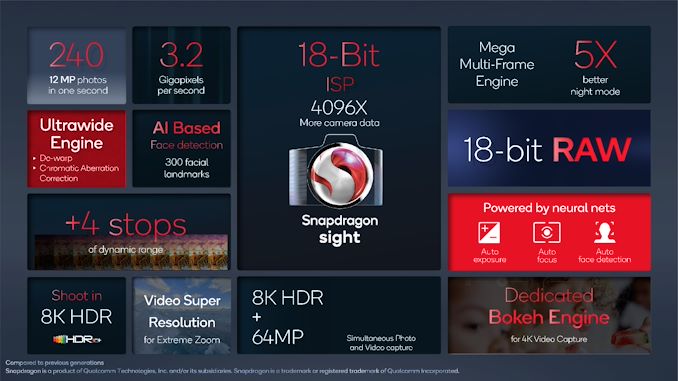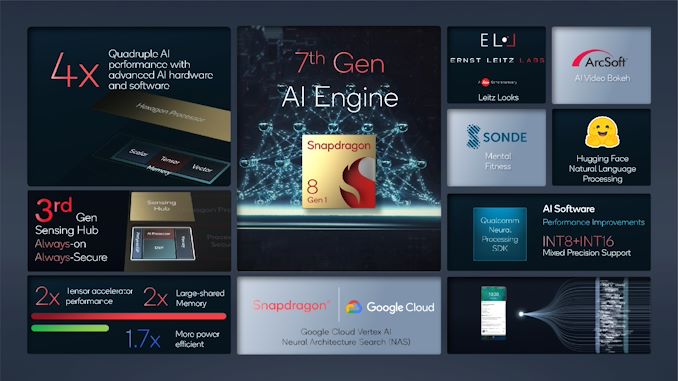Qualcomm Announces Snapdragon 8 Gen 1: Flagship SoC for 2022 Devices
by Andrei Frumusanu on November 30, 2021 6:00 PM ESTMassive ISP Upgrades
I’ve been hearing for some time now that 2022 flagships will have massive camera upgrades, and the new features of the next-gen SoCs being described by MediaTek and now also Qualcomm explain why that is.
The new ISP of the Snapdragon 8 Gen 1 falls under a new marketing name – “Snapdragon Sight”, and includes large improvements of the capabilities of the IP blocks within the image processing chain.
The big flagship feature being advertised is the fact that the new ISP is now capable of 18-bits of color depth per channel, up from the previous generation 14-bit ISP. While mobile image sensors nowadays still are barely 12-bit native in terms of their ADCs, the ushering of new HDR techniques such as staggered HDR capture, where exposures are immediately subsequent to each other on the sensor’s readout, means that new phones now are able to capture images a lot faster, recombining them into higher bit-depth results. Particularly here, the new 18-bit ISP pipeline now allows for three exposure HDR stacking off these new sensors.
The increased bit-depth should allow for an increase of 4 stops in dynamic range (or 2^4 = 16x the range), which greatly helps with very contrasting environments and challenging lighting situations. This is quite beyond any other camera solution right now, and being able to have this implemented in such a hardware fashion sort of blurs the line between traditional image capture techniques and the more software-defined computational photography methods of the last few years.
Indeed, the new ISP architecture seems to be very much a way to implement many of the existing computational photography techniques into fixed-function blocks: there’s a new neural-net controlled 3AA (auto-exposure, auto-focus, auto-white-balance) and face detection block, which sounds eerily similar to Google’s HDRnet implementations.
Night mode is also said to be vastly improved through a new multi-frame noise reduction and image stacking block, being able to now stack and align up to 30 images, and achieve also much finer detail this generation. Qualcomm here claims up to 5x better night mode shots.
Further improvements include a new distortion correction block that’s able to now also correct for chromatic aberrations, and a hardware video Bokeh engine, being able to operate at up to 4K video recording. Think of it as the same as the new Cinematic mode on the new A15 iPhones, but not only limited to 1080p.
Qualcomm notes that all the AI/ML/neural network features on the ISP are actually run and accelerated on the ISP itself, meaning that it is not offloaded onto the Hexagon dedicated ML processing blocks or the GPU.
Just as a note- Qualcomm’s 3.2Gigapixel/s throughput metric here seems low compared to the Dimensity 9000’s 9Gpixel/s, it’s possible that the companies are advertising very different metrics, with MediaTek advertising the throughput of lower-bit depth pixels coming from the image sensors per frame, while Qualcomm quoting the full bit depth pixel processing within the ISP itself.
In terms of video encoders and decoders, the new chip allows for 8K HDR recording now, but otherwise is seemingly on par with the Snapdragon 888 media blocks. Unfortunately, this also means no AV1 decoding this year yet again. Qualcomm isn’t part of the Alliance for Open Media consortium and instead is backing VVC/H.266 and EVC, however with AV1 being actively pushed by Google and YouTube, and seeing large adoptions such as by Netflix, it’s becoming questionable for Qualcomm to still not support the format in 2022 devices.
AI Performance - Iterative, but solid
Last year’s Hexagon IP block was a very large change for the Snapdragon 888. At the time, Qualcomm moved on from a more segregated DSP/AI architecture to a single more fused-together block being able to operate on scalar, vector, and tensor operations at the same time. This year’s iteration is an improvement of that larger change. Qualcomm notes that amongst many changes, they’ve doubled up on the shared memory of the block, allowing for greater performance for larger ML models (which are growing at a very fast pace).
Qualcomm didn’t note any TOPS figures this time around, instead stating we’re seeing 2x the tensor throughput performance, and smaller increases for scalar and vector processing. They do quote a day-1 to day-1 performance increase of 4x when compared to the Snapdragon 888, via a combination of both hardware and software improvements, but of course that figure is smaller when comparing both platforms on an equal software footing.
Power efficiency for AI workloads is said to be 70% better this generation, which is actually more significant, and should help with more demanding sustained ML workloads.
X65 Modem Integrated
In terms of connectivity, the Snapdragon 8 Gen 1 is quite straightforward, as it integrates the X65 modem IP that Qualcomm had already announced as a discrete model earlier this year.
The improvements here are the fact that it’s a 3GPP Release 16 compatible modem, including new features such as uplink carrier aggregation. Other improvements are 300MHz of Sub-6 bandwidth on 3 100MHz carriers, and an increase of the mmWave bandwidth from 800 MHz to 1000MHz, allowing a new peak theoretical downlink speeds of 10Gbps.












219 Comments
View All Comments
Nicon0s - Wednesday, December 1, 2021 - link
I mean what exactly makes you think Apple objectively made bigger improvements in CPU arhitecture in the last few years?Apple's CPU approach is quite obvious: very wide CPU cores with huge amounts of cache. Realistically that can be replicated but the thing is stock ARM designs try to be efficient from a die area perspective as well.
If Samsung's 4nm is solid and SD8G1 Android phones won't have heat problems you will hardly be able to sense a real world difference in performante vs an iphone with A15.
mode_13h - Wednesday, December 1, 2021 - link
> Apple's CPU approach is quite obvious: very wide CPU cores with huge amounts of cache.For starters. To see what else they've done have a look at name99's 350 pages of collected research on it:
https://drive.google.com/file/d/1WrMYCZMnhsGP4o3H3...
> stock ARM designs try to be efficient from a die area perspective as well.
True, ARM's X-series cores are still just 7-series cores on steroids. They weren't truly designed for max performance from the ground-up.
Their server cores suffer from a similar affliction, being derived from their mobile cores.
> you will hardly be able to sense a real world difference in performante vs an iphone with A15.
That's a whole different discussion. As we've seen, Apple's cores were designed with more lofty goals in mind than mere phone UX.
michael2k - Thursday, December 2, 2021 - link
But you’ll see a much bigger difference when you stick the part in a less thermally and battery constrained laptop.That’s wher Apple is using an 8 or 10 core design instead of a 6 core design.
Nicon0s - Friday, December 3, 2021 - link
The SD8G1 is not a laptop SOC at all, not even a tablet SOC so I don't see how such a comparison is relevant.Qualcomm's current biggest disadvantage is the lowest quality manufacturing process.
Kangal - Sunday, December 5, 2021 - link
With the throttling and performance we have on the QSD 888+, would you rather classify that as a "Phone SoC" or a "Tablet SoC" ...?I think the QSD 8-Gen1 is going to behave very similar to it, possibly with its own quirks.
AciMars - Wednesday, December 1, 2021 - link
Hey Andrei, are you confirmed S8Gen 1 has 4MB System Cache? Because SD888 just use 3MB System Cache. Need Clarification on your Table InformationAndrei Frumusanu - Wednesday, December 1, 2021 - link
I asked Qualcomm in our briefing and they said it was "unchanged" at 4MB. So it seems the 3MB prior reporting was wrong.ZolaIII - Wednesday, December 1, 2021 - link
Really interested in seeing A510 metrics and impact of shared L2 cache and how it compare to older ARM small core's with shared L2. Old implementation whosent very good and leed to performance degradation when both core's where active and had to wait on it, that's why they abandoned it in the first place.ceisserer - Wednesday, December 1, 2021 - link
What a boring release - especially keeping in mind the 888 wasn't that overwheling either.No AV1 decode in 2022 (?!?!?!) and just 20% faster cores - guess I'l keep my Snapdragon 835 powered phone for another year, or if it dies, buy a Mediatek Dimensitry 9000 based one...
defaultluser - Wednesday, December 1, 2021 - link
The worst part of this : Qualcomm is still stuck on Samsung for the foreseeable future.The Dimensitry 9000 will be more efficient TSMC part!